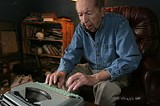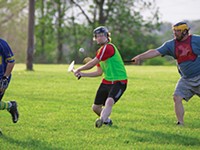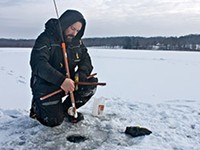[
{
"name": "500x250 Ad",
"insertPoint": "5",
"component": "15667920",
"parentWrapperClass": "",
"requiredCountToDisplay": "1"
}
]
George Beahon wrote more than 5,200 sports columns during nearly a 50-year career for Rochester's Gannett papers. Author Curt Gerling, in his 1957 book Smugtown, U.S.A., called Beahon "the poor man's Red Smith." Smith worked for the New York Herald Tribune and later the New York Times. Many people --- even the 84-year-old Beahon --- consider him the greatest US sportswriter.
Rochester had the feel of a big city throughout most of Beahon's career. The Royals were in the NBA. And there were fewer major-league teams in baseball and hockey, which meant better players and competition for the Red Wings and Amerks.
Rochester also hosted the Hickok Belt, the country's premier annual pro sports award. The Press-Radio Club, which Beahon headed in 1958, presented the belt every year from 1950 to 1971, and it always received major media attention with recipients such as Willie Mays, Arnie Palmer, and Jim Brown.
Beahon graduated from Aquinas in 1937, and worked at Berger Brothers Electric for three months before quitting. (His boss wouldn't let him to listen to the World Series.) In the late '30s, he began at the Democrat & Chronicle before enlisting in the Navy for three-and-a-half years during World War II. He returned to Rochester and was eventually elevated to the Democrat's Red Wings and Royals beats before taking over a slot as a daily columnist.
Beahon's first interview couldn't have been bigger. It was Babe Ruth, when the retired slugger appeared at Red Wing Stadium on a one-man tour during the '40s. Beahon was awestruck. He can't recall what he asked or wrote. He just remembers Ruth's appetite for beer and hot dogs.
City Newspaper recently caught up with Beahon in his Pittsford home. Following is an edited transcript of that conversation.
City:What's your favorite sport?
Beahon: I love baseball. The steroid thing is a cancer. What Major League Baseball is going to do with Jason Giambi is the most important thing that's going to come out of spring training. Barry Bonds has probably got to go too. The game should throw these people right out.
I used to cover all of the World Series. The last one was '82, between the Cardinals and Milwaukee. I stayed at [former Red Wings and Cardinals broadcaster] Jack Buck's house. The writers now [at the Democrat] haven't gone to the World Series lately. Bob Matthews doesn't go anyplace. He doesn't even go to Bills games.
City:Is there any comparison between sports coverage now and the past?
Beahon: No. The Democrat is overdoing the advance stories. Syracuse basketball gets two page-one stories and the Bills get too much, too. They force it down our throats. Neither one of them is from Rochester. Print journalism is falling behind. The best stuff is in magazines. Newspaper journalism is just flat. There's nothing personal or in-depth. Can you tell me one of the Amerks who you really know?
Some of the best stories I got came from bars. That was the advantage of traveling with teams. You'd get in restaurants, or sit around and wait for planes and trains, and the athletes were away from the censorship.
City: Which sportswriters did you look up to?
Beahon: Red Smith and [the New York Post and Journal-American's] Jimmy Cannon were two of my heroes. Smith especially. I got to know him a little bit. He was at another level. He spent a lot of time with his sources. That doesn't happen today. The teams are censoring the press. The press are employees. I don't think the public is smart enough to know the difference.
Red Smith was the most enjoyable person I was ever around in athletics. I saw him at the World Series and at the Hickok Belt dinners. I met him on the train from New York to Rochester once. [Boxer] Dick Tiger was on the train, and there was actually a fire. But it didn't bother Red much. He talked to Tiger for about five minutes, put the typewriter on his knee, and wrote a column.
[Major League Baseball] always had a dinner after every World Series game. It was late and I'm standing next to Red at the urinal and he looked up at me and said, "Where would you rather be?" He had it right. There was no place I'd rather be. The World Series was a picnic.
City:With Gannett owning both Rochester dailies, how was the competition between the two?
Beahon: There was good competition. We were always trying to beat the other paper desperately. When [Red Wings manager] Harry Walker went from Rochester to St. Louis [in 1955], I was hanging around the clubhouse. I was close to the coach and he gave me a wink and said, "Keep an eye on Harry tonight."
I didn't pay a great deal of attention until Harry got himself kicked out in the first inning. So I left the press box, went down to the clubhouse, saw that Walker was dressed, and said to him, "Harry, you going to St. Louis?" And he said, "I can't talk." I went to the airport and caught him getting on a plane. I had it in the morning paper that Walker was going to St. Louis. This shocked the hell out of the guy who was working for the Times-Union.
I wish the Hearst paper [Rochester Journal-American] never left [in 1937]. Some say that the politicians and businessmen didn't want another paper looking over their shoulder, and it was probably quite true. Rochester was pretty smug.
City:Did you ever contemplate leaving Rochester?
Beahon: I had some chances to get out. Maybe I should have taken them. I could have covered the Dodgers for the New York Journal-American. But I had a lot of relatives here. I didn't like leaving them. With baseball and the Royals, I was gone half the year. I hate to think I've been categorized a hometown boy, but it was tough to leave all the people behind.
City:Who was the greatest athlete you ever covered?
Beahon: Boxer Carmen Basilio. Carmen broke all of my ribs once. He hit me a little hard and I was in trouble for a week. I'm not OK, even now. Well, I'm as OK as I'm ever going to be.
Minneapolis [Laker] George Mikan was another great athlete. I've heard the story about him getting a knife thrown at him at a Royals game here, but it's not true as far as I'm concerned.
And I can't forget the Royals' Al Cervi, Red Holzman, and Arnie Risen. Risen beat three Knicks centers in the '51 NBA Finals. New York coach Joe Lapchick threw three big guys at him and they were all good, but Risen just wore them out; he out-fought and out-skilled them.
With Cervi, Holzman, Bob Davies, and Bobby Wanzer, the Royals could move the ball around for four minutes. The 34-second rule abolished that, but it was a pleasure to watch. There weren't four guys like that anywhere in the league.
Latest in Sports
More by Mike Doser
-
They’re football players
Aug 10, 2005 -
Are sports dying?
Jul 27, 2005 -
Are sports dying?
Jul 27, 2005 - More »






